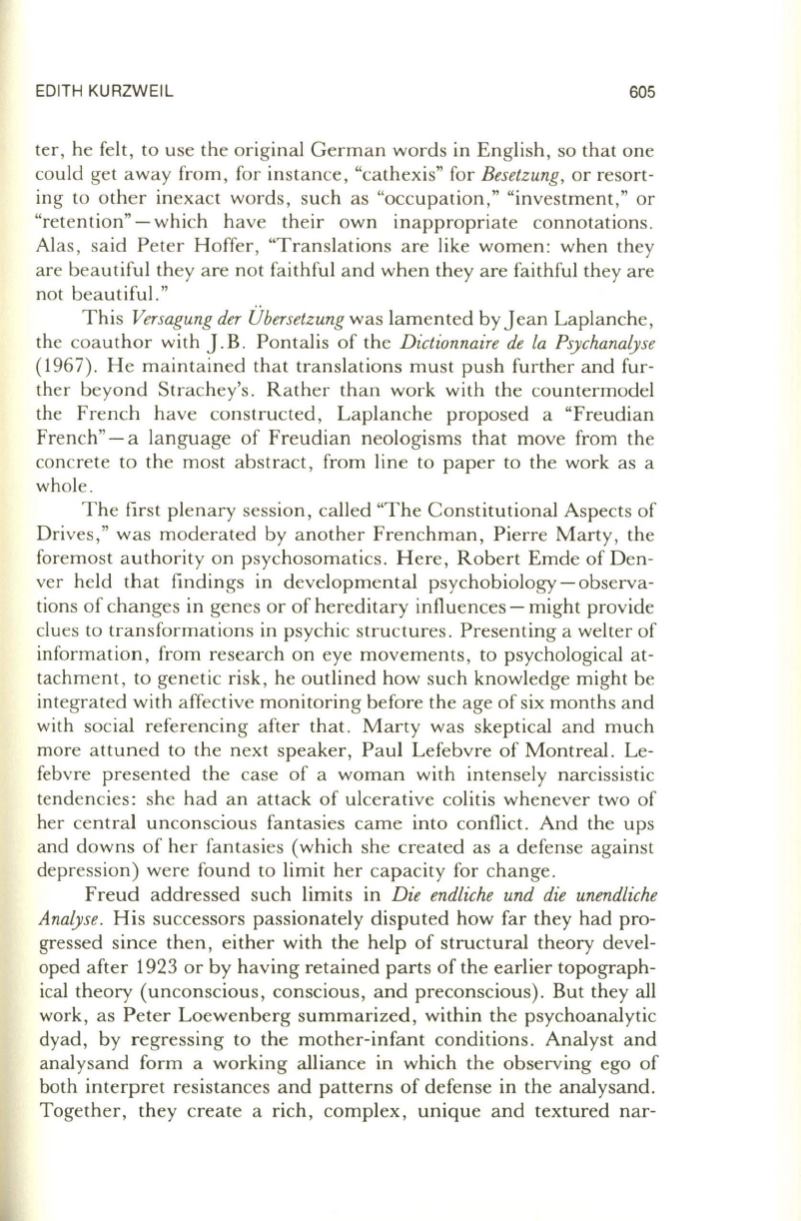
EDITH KURZWEIL
605
ter, he felt, to use the original German words in English, so that one
could get away from, for instance, "cathexis" for
Besetzung,
or resort–
ing to other inexact words, such as "occupation," "investment," or
"retention" - which have their own inappropriate connotations .
Alas, said Peter Hoffer, "Translations are like women: when they
are beautiful they are not faithful and when they are faithful they are
not beau tiful."
This
Versagung der Ubersetzung
was lamented by Jean Laplanche,
the coauthor with J .B. Pontalis of the
Dictionnaire de La Psychanalyse
(1967). He maintained that translations must push further and fur–
ther beyond Strachey's. Rather than work with the countermodel
the French have constructed, Laplanche proposed a "Freudian
French" - a language of Freudian neologisms that move from the
concrete to the most abstract, from line to paper to the work as a
whole.
The first plenary session, called "The Constitutional Aspects of
Drives," was moderated by another Frenchman, Pierre Marty, the
foremost authority on psychosomatics. Here, Robert Emde of Den–
ver held that findings in developmental psychobiology-observa–
tions of changes in genes or of hereditary influences - might provide
clues to transformations in psychic structures . Presenting a welter of
information, from research on eye movements, to psychological at–
tachment , to genetic risk, he outlined how such knowledge might be
integrated with affective monitoring before the age of six months and
with social referencing after that. Marty was skeptical and much
more attuned to the next speaker, Paul Lefebvre of Montreal. Le–
febvre presented the case of a woman with intensely narcissistic
tendencies: she had an attack of ulcerative colitis whenever two of
her central unconscious fantasies came into conflict. And the ups
and downs of her fantasies (which she created as a defense against
depression) were found to limit her capacity for change.
Freud addressed such limits in
Die endLiche und die unendliche
Analyse.
His successors passionately disputed how far they had pro–
gressed since then, either with the help of structural theory devel–
oped after 1923 or by having retained parts of the earlier topograph–
ical theory (unconscious, conscious, and preconscious). But they all
work, as Peter Loewenberg summarized, within the psychoanalytic
dyad, by regressing to the mother-infant conditions. Analyst and
analysand form a working alliance in which the observing ego of
both interpret resistances and patterns of defense in the analysand.
Together, they create a rich, complex, unique and textured nar-


